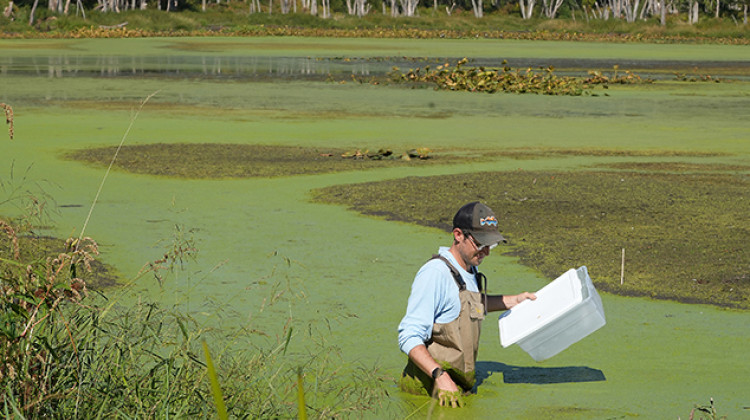
Purdue Universitys Tyler Hoskins in the field at the Purdue Wildlife Area. (Purdue Agricultural Communications photo/Tom Campbell)
Tom CampbellPurdue University researchers are studying how toxic PFAS could affect aquatic life in the most contaminated areas. The human-made chemicals are found in all kinds of nonstick and stain-resistant products we use today.
Researchers looked at how five different kinds of PFAS interacted together to mimic exposure for aquatic life living next to something like an airport or a military base — which historically used toxic firefighting foams. They found the chemicals stunted the growth of northern leopard frog tadpoles.
Tyler Hoskins is an ecotoxicologist and assistant research professor at Purdue. He said these kinds of studies are hard to do. They take a long time and some lab equipment also contains PFAS, which can make it difficult to get a good baseline for the research.
Hoskins said these studies are important because they tell us more about what PFAS exposure things like tadpoles might get in the real world.
“So they're being exposed to dozens to hundreds to potentially thousands of these chemicals, depending on the source. And so it's really important to look at complex mixtures because it's representative of what the organisms get in the field," he said.
READ MORE: What to do if there are PFAS in your water
Join the conversation and sign up for the Indiana Two-Way. Text "Indiana" to 73224. Your comments and questions in response to our weekly text help us find the answers you need on statewide issues, including this series on climate change and solutions.
Purdue ecotoxicology professor Maria Sepúlveda said researchers were also surprised to find that newer PFAS chemicals — meant to replace those that build up in animals’ bodies — were just as toxic when they were exposed continuously over time.
“So they don't bioaccumulate — we know that. That doesn't mean that they're nontoxic," she said.
Unlike PFOA and PFOS, PFAS-like GenX chemicals have not yet been phased out of production in the U.S.
Rebecca is our energy and environment reporter. Contact her at rthiele@iu.edu or follow her on Twitter at @beckythiele.
9(MDAyMzk1MzA4MDE2MjY3OTY1MjM5ZDJjYQ000))
 DONATE
DONATE






 Support WFYI. We can't do it without you.
Support WFYI. We can't do it without you.